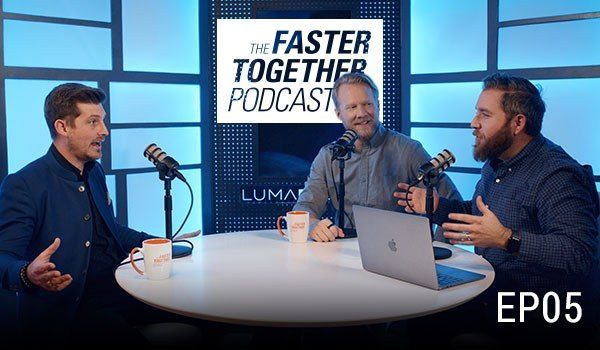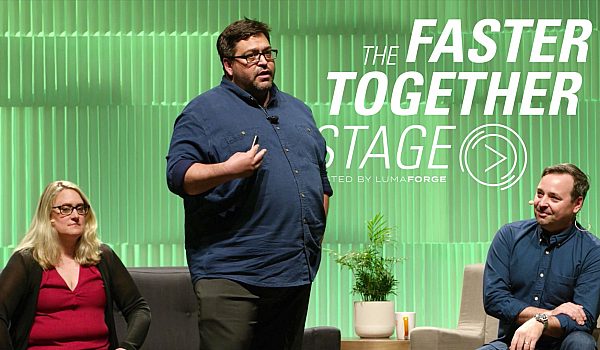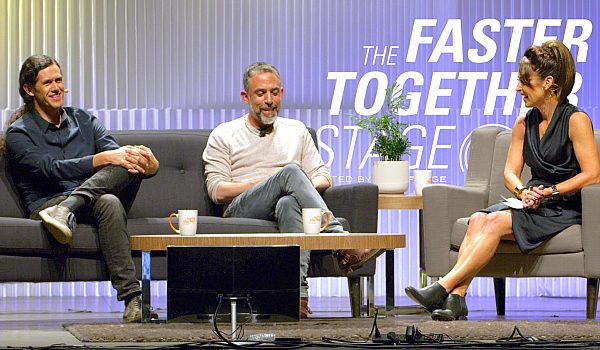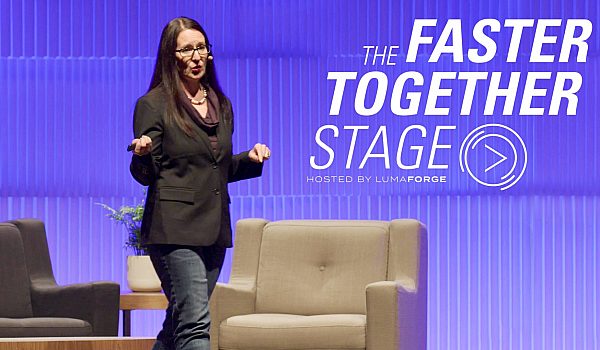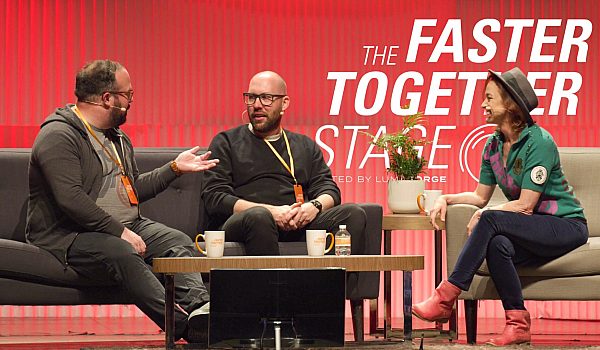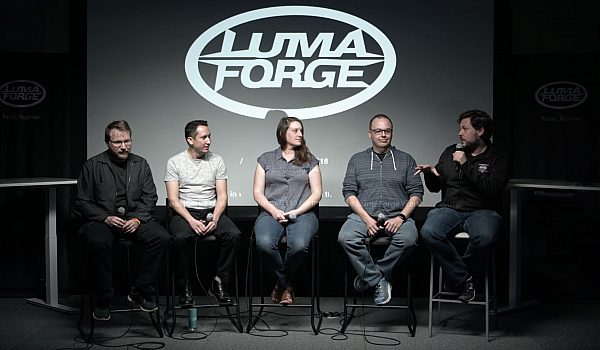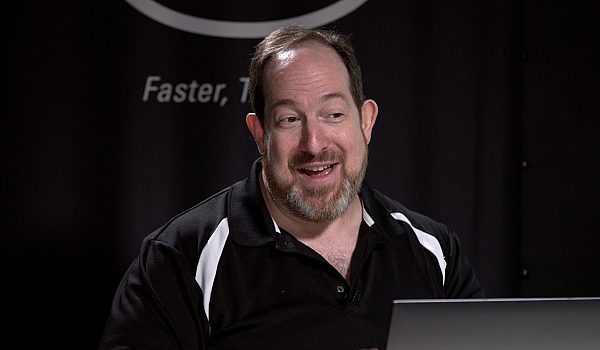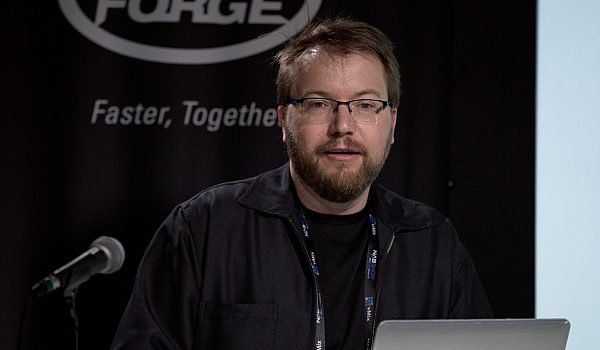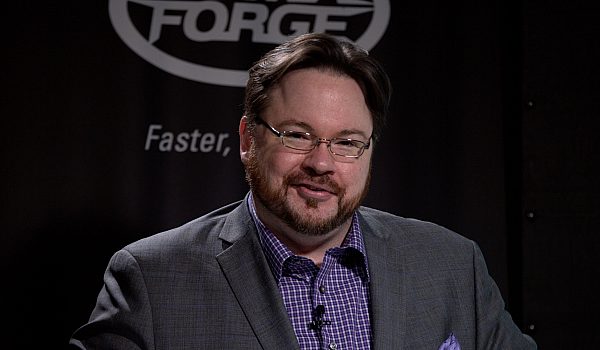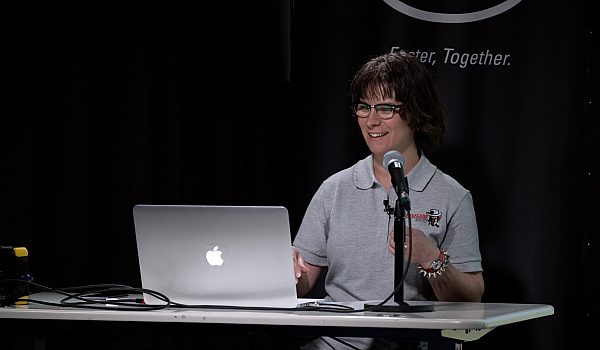Learn about how post can be done under one roof using Mac, Windows & Linux machines for Editorial, VFX, Color & Sound. Sam Mestman also presents updates to the LumaForge Jellyfish & Sharestation.
What all of these presentations are about is workflow and workflow is how do you tell the story that your client wants to tell. And so we decided that maybe we'd kick this off with the most interesting aspect of post-production, which is shared storage. Um, I was supposed to get a laugh or something. How many of you guys are passionate about shared storage? That is shocking. I am not passionate about sharing storage to be honest with you. I actually hate shared storage. Um, but part of that is why we started this company because things are way too complicated now and things have become, there's so many different things that we are told like this is the way to do it. This is how to do it. And how many of you guys as you work on projects, uh, find that, you know, there's a lot of communication between departments and that everyone's really talking to each other about how everything should get done and was really serving the story that they're trying to tell.
Is that, I mean that's a common thing, right? You know, um, I think we all know that like there is some major room for improvement in terms of communication between departments and actually serving the stories and the things that we are actually trying to tell. And so we are here for essentially one reason, which is to make life easier for video professionals and to solve problems. So we create products that solve problems. We started with products that solved our own problems. And so the biggest problem that we have at the moment is that nobody talks to each other. And uh, there isn't a good way to link up all of these various departments and all of these competing interests. In the last 18 months. This concept has taken us to five continents and 15 countries. We're actually about to add our sixth continent shortly and the next couple of weeks we'll be in Africa.
And uh, basically it's this idea like this is, I mean this is not about tech specs or white papers. We can talk ad nauseum around codex and frame rates and all this stuff. But in the end, this is about people working together to deliver a product. They're being paid for or they're passionate about. And how do you do this in the best way possible to make everyone look good? Like I think we all got into this industry because we were passionate about it. And somewhere along the line, some of this got lost where we are now focused on I think on the wrong things, which is like, how do we do this? You know, what, what is the technically perfect way to do this when, when really it's about how do you connect your team in the right way and how do you focus on the craft and what is the best way to serve your client and serve your story.
So this slide right here is the of everything that is wrong in postproduction. And currently this is how most high end productions are built. Uh, whether it's on the feature film or high end commercial side. I'm going to quickly walk through this, um, really simplistic diagram. Um, you know, it starts on set, uh, where you're going to have a DIT who's gonna make multiple copies. Typically post-production will not even be involved in the conversation, uh, around how post is going to get, receive and manage everything that's happening in production. So you're gonna have a lot of people having a conversation around, here's what we're going to do in production, and then we're going to hand it off to a dailies lab. Or in some cases, the dailies are going to be processed on set, but no matter what, typically the original media is going to live separate from the editorial who is going to be working in another facility and they're going to be working on an analytic choice with offline media.
Typically, they're not going to have access to their media, but then what's going to happen is they're going to finish this off fine cut, and they're gonna have to find a way to get back to their original media that lives back at the lab. Meanwhile, they're going to have to work with a graphics artist on online and colorist who's going to get this original media. And then oftentimes they're going to work remotely with the VFX department that may not even be in the same country or speak the same language as them. So in a typical environment, you may see people creating a spreadsheet for every single VFX shot that is then going to have to be sent to the lab where they're going to pull these frames, and then they're going to collaborate with the VFX supervisor who does not work with the team, who is going to get these frames.
And then they're going to have artists work on them and then they're going to send them back and then they're going to figure out how to work these into the edit with the colorist. Meanwhile, the sound department needs a locked edit that cannot possibly change, and the graphics guys are delivering elements for a movie they think is finished, except when someone, when the director comes in to look at this and like, this is not what we wanted. Then everything changes and you have this thing. And if you look at these lines, basically you are following all of these lines and you're getting a lot of different answers from a lot of different people. And oftentimes none of these departments are even living under the same roof. So basically when you get into this situation, oftentimes if you are a post production supervisor, the experience can feel like this.
The sort of idea of this is that like it just really should not be this way. And I think projects across the line, suffering in the game over is really in reference to the budget and the unhappy client that results from this workflow. And so the problem that we're solving at LumaForge is how do you create a foundation for all of these different departments to connect to each other. And theoretically with this little box down there, the jellyfish or our larger facility workflow, the share station, you can get onto a platform like this that can even start happening on set where you're building media and involving posts in the process from the very beginning, allowing multiple members of the team to speed up and actually inform production workflow where then that's going to feed into editorial where they're able to access their original media as well as any trans codes that are necessary and oftentimes even just proxy files that can flip immediately back and forth between the original media and the proxy files.
Meanwhile, you have a graphics editor who's in the next room who can collaborate this way and work from that media and they're working in their final resolution the entire way so that you can have an in-house colorist coming in and basically working from that original media and collaborating directly with the director, editor and sound designer who's in the next room as well as the VFX supervisor who was doing the majority of the heavy lifting on the VFX side, rendering all of these spreadsheets sort of obsolete and you have a team of people who were suddenly getting an optimized connection for video where they can go and collaborate with the review process and something like frame IO in the cloud or even start passing frames that can live directly on your server to your remote. The effects department that can be updating in real time for the colorist and editorial departments.
Meanwhile, if you look off to the side, you can build a little archive trailer or house or garage where basically you are archiving automatically with snapshots out to your archive station, which then can get backed up into the cloud. And our opinion is this is a far easier approach to modern workflow. Meanwhile, no one has to sacrifice the way that they want to work or the speed in which they want to work. So for us, solving this problem is necessary to have optimized foundation upon which to build this. So theoretically, if you are in an environment like this and you are a post supervisor, you may have an experience like this.
Patrick Southern, everybody. So, um, you know, we, you got to keep it interesting for shared storage. Like that's, I mean like we do our best here, but, but the, the concept of this is about creating an environment that is actually pleasing to the people working on the projects and fosters a sense of communication and accountability between departments and makes the process easier. And when you are working this way, it makes your clients a lot happier. And frankly you are able to turn around projects that actually meet the demands that are now being placed on post-production. So basically this is our version of the anatomy of what a modern post-production work group can look like, which is essentially taking the needs of all of these various departments, sound graphics, online color, connecting them to the same storage and giving them the optimized video connection of their choice directly to the client where they can work in the application of their choice.
Always referencing the original media and collaborating in any way that they want to go. So for instance, final cut, premiere resolve, avid, it doesn't matter. Logic, ProTools, Reaper, audition, it doesn't matter. New fusion after effects motion, it doesn't matter. PC, windows, Linux, it doesn't matter. You should be able to work the way that you want to work with the application that you want to work. Hire the people that you want to work with and have them all connect in the same way and give them what they want so they can make you look good. That's the idea with post-production for somehow somewhere along the way that's gotten a little bit lost. And that is sort of the problem that we are trying to solve here at LumaForge with the products that we're building. Basically this is our stream chart, um, which is, you know, across our various products, some of which I'm going to be, uh, are new ones that we're talking about in a little bit today.
But this can give you a sense of what you can do across all of your various systems. Starting from the little jellyfish mobile down there, all the way up through our share station and giving you a sense of what your video departments can pull in the real world around some of this. And if you sort of look at these stream counts, there are very few productions that cannot be managed with what we are providing here. So I can go all day talking about performance, how many megabytes a second, what type of connection you can do. And that's a conversation that I'm happy to have with anyone separately. But the general idea with this chart is to show you what you can accomplish if you want to and the types of bandwidth that you can actually deliver to your post production teams. The reason that we're able to do this is basically our backbone, which is a ZFS backbone, which is the world's most modern file system for a video server technology.
And we are ethernet based. Um, and essentially you can deliver a one, 10, 40, gig, 25 gig or even a hundred gig connection, which we'll talk about on the share station and a little bit. Um, you can deliver this and because of the ZFS works, it is optimized for video maybe in a way that some other shared storage platforms might not be. And basically we're about to launch a new back end coming this summer that is going to build on the ZFS foundation and add and continue to add more useful functionality for everyday video editors. We don't make shared storage for anything except for what video editors do with it. And the company that we were building in the platform that we're on is going to allow us to add significantly more postproduction usability for post departments as opposed to just maybe features that were thrown in there based on a conversation or maybe based on an entirely different vertical.
Our products are 100% focused on what editorial VFX and color and sound teams do on a day to day basis. So it starts basically in the high end facility we are fully compatible with windows active directory eldap uh, and OSX server. So basically no matter what sort of users are permission-based platform you want to run, we are totally compatible with that and it's really deep and interesting conversation if anyone wants to have that later. Um, it's really not that interesting. It's painful but we are compatible specific to NLS. We built this product initially for final cut 10 users because there was not shared storage that was optimized for final cut 10 libraries basically final cut, 10 libraries demand responsive, high performing shared storage that works. Kind of like your internal SSD. And our goal was as we were going through some of the other solutions that we had been integrating was we could not find something for whatever reason that was allowing us to perform the way that we were performing from our local storage to ZFS.
And the way that we optimize our caching, we, Mo we leverage three and actually now kind of a fourth level of cashing to deliver the bandwidth required so that your final cut 10 libraries can run on shared storage as well as your cash without seeing any performance dip versus what you're doing on local storage. And on top of that, we're now building for other platforms as well. How many of you guys have done resolve collaborative workflow? Okay. That may change. And the reason is it's really, really hard and complicated to set up. So what we done over at LumaForge is build that into the back end. So you are basically immediately compatible with resolve collaborative storage. So if you have multiple people accessing resolve, they can go into collaborative mode, which, uh, we have Robby, Patrick and rich talking about later today. And you can immediately get down to business and you don't have to worry about what is kind of a complicated setup to get some really high performance collaborative features.
So, uh, we are fully compatible with DaVinci resolve collaboration. Uh, we also fully support all of the Adobe premier apps and you can even do avid bin locking with a little third party product called Minnick. So no matter what NLE that you're doing, you can work at the highest level of collaboration, uh, with any Anneli that you choose. And additionally, we're compatible with a host of media asset management systems. And basically our goal is to talk to every manufacturer and be like, what do you guys need? And we figured out how to do that with our clients so that we can deliver for video departments exactly what they need to be successful. And we support all of these solutions. And that's sort of, I'll talk about that in a little bit, but like we are building a platform that anybody can use regardless of what their workflow is.
That is our goal. And the additional thing that we are now, uh, basically going to be working out is we have archives snapshots that if you guys are familiar with time machine, basically it's like time machine for your server that can be snapshotted anywhere and updated incrementally. So you're not going to do an entire backup. You're going to increment just the things that have changed on your volume. And this can be going be done directly in the ShareOS back end. And what it really comes down to is this slide, which is, this is an email that I got with these two pictures with this actual quote, uh, which is essentially, if you look at the picture on the left, this is maybe what you guys have noticed, a server room, um, the picture on the right, that box didn't even need to be in that server room.
They just put it there cause they had a server room. Um, but that box is actually right there and we're going to be working off that box through various presentations over the next three days. Uh, and the idea of what this can open up on the workflow side when you take all of these features and sort of string them together is an environment where, or imagine what happens when you don't need a server room for something. What can you do? What can you do on set? Uh, what can you do with your post team to have them start talking more to production? We had, we shot our pilot off the grid where we had post working completely on set with three machines and basically we were blazing through this, this shoot in a way where like I as the director could literally be checking in and making sure that we were making our days in an extremely limited timeframe and making sure that we could correct any error that we might see are making sure that all the shots were working together.
And this is something that is different than how people approach shared workflow. So, um, the next aspect of this is, this is sort of a hobby that we are sort of evolving into, which is one of the things we did on off the grid was use shot notes. Do you guys know what shot notes is? More or less? Basically shot notes is something that is largely a tool for script supervisors to allow them to enter metadata on set so that and then via XML, apply this metadata into a final cut 10 library so that all of your stuff becomes immediately searchable. And when you combine that with a tool like sinking link, you can have a fully sinked, a searchable library in final cut, completely automated without any renaming or any of this stuff within 10 minutes. And you can immediately search he words or search notes or any of those things.
And this happens within 10 minutes of downloading from set. If you basically have someone fill out a Google spreadsheet on set, instead of giving you a binder that you never open again. And we're taking this concept of an existing software that we developed with Kevin. Kevin, are you here? You ovens in the back. So Kevin is the designer of shot notes and we're working with Kevin on something new that we're kind of passionate about, which is Shareflow, which is taking the concept of um, building your video assets on set and then giving it sort of a visual overview that then allows you to not only get into just final cut 10 but also get into premiere and resolve or any asset manager that you're using for larger asset management needs. And the idea is instead of an asset manager, this is a metadata manager. This is something that's going to allow you to feed assets to whatever platform that you need.
And basically this is actively evolving. You can see this in the workflow suite in sort of its basic format. But the idea is you can put this on top of the jellyfish and start building a way to keep your data no matter what project you're doing and shoot this into whatever application that you actually need. So an in a sort of visually pleasing way. So this is sort of a hobby for us. It's coming this summer. It's going to be free for all LumaForge customers and you guys will all be welcome to be involved in the beta on that. That's going to be coming this summer, so we definitely want your feedback. We want to turn this into a platform for people to basically find things easier. Additionally, on our share client app, we are now opening up a windows and Linux version of the app as well so that we were going to take the same ease of use and connection that you get in share client and you're going to be able to open that up in a Mac, windows and Linux environment.
This is the fastest, easiest way to connect to a server. Part of the reason that we've made it so fast and easy is that it had to be something that I could actually use and so that we've sort of taken that approach and we're trying to simplify that for windows and Linux users, there is no easier way. In fact, it's down. I think we've got it down to two clicks from connecting your Mac for the first time to getting up onto your shared storage and getting everything optimized and getting the right settings. Um, so basically we have gotten to virtually plug and play when it comes to shared storage environments and we have built solutions that do not require intense it. Now a lot of people will say, well, am I going to be out of a job if I'm an it manager? No. The idea is actually to allow it to do its job better, whereas opposed to be a gatekeeper from people and there and sort of treating their users like they have to have sort of safety helmets on.
Um, basically the idea is to allow it people to do what they're really good at, which has helped their team do more and that sort of, the vision we see for the it person is looking at all of the technology that's available and figuring out processes and workflows for their teams to follow and helping their users create the environment where all of these projects become better. So I don't feel the it person should be a gatekeeper or they need to have, they're just going to go in and tell you or connect you to the server. I fill the role of the it person should be to make life easier for their users. And that's sort of what we're trying to do with share client is remove an aspect of it so that they can get freed up to actually do more. And so one other thing that we're showing is uh, if you guys notice, uh, there's a new Mac book that um, is uh, built for Thunderbolt three Thunderbolt three is actually built for the 40 gig ethernet standard.
And over in the workflow suite we are now running 40 gig ethernet. We partnered with that O that we're still optimizing but we have exceeded Thunderbolt two speeds. You can see this in the workflow suite where we can run 40 gig ethernet direct to the Mac platform now, which is now going to open up 4K DPX and EXR playback on the Mac platform and as the new iMac and Mac pro com. This is going to be designed for you guys to have an optimized connection where you can basically go, I don't know, faster than you really ever thought you could go. Um, and this can now be done on the Mac. So we are ready for Thunderbolt three in a way probably that that few other companies are and we are actively building on these speeds and we're expecting to be able to do all of these things as soon as we have the new Mac updates.
And so you guys can see all of this in the workflow suite, but in terms of what we're doing on the actual product line itself, this is the jellyfish mobile. A couple of things that you should probably know about it is now expandable. So if you take a look at that, you can add two additional chances to get up to 240 terabytes of portable shared storage that you can pretty much set up in any environment the jellyfish is currently on. That's about as loud as it gets. So you can bring this onset and work and build a massive, uh, sort of amount of data with this. And, uh, we're also doing something interesting where for really high end, uh, use cases or for DIT, we're building all flash and hybrid configurations. Those are going to be ready this summer where basically it can be all flash in a jellyfish where you can open up all that 4K, DPX and EXR bandwidth and performance right in that little box.
And you can also on the hybrid side, this will allow you to have a mixed three and a half inch pool and a flash pool where you can give different types of assets or have multiple sort of pools where you can maybe ingest on one transcode and archive separately and you can deliver the type of storage that no matter even out of that little box that your team might need. So this is as far as we're concerned, uncompromised shared storage in a tiny portable quiet form factor. And this is, it's already sort of changing workflows across the world, but we feel like this is the solution that people have kind of been waiting for, which is uncompromised shared storage. That's really easy to set up, portable and you can take anywhere and it's expandable. On top of that, uh, we also have the jellyfish tower, which is as far as I'm concerned, kind of our coolest product.
Uh, it is basically the power of rack mounted storage in the room with you. You can see this over at the workflow suite. Uh, we have a Mac windows and Linux environment currently running, uh, where you can see 16 streams of 4k on a Mac. You can see 4k open EXR on Linux and you can see 16 streams, uh, pro res in on windows and premiere as well as fusion workflow, et cetera. All working in perfect harmony, resolve collaboration going between Mac windows and Linux, all from the same server. And the bottom line is it's also whisper quiet. You can get up to 200 terabytes, add up to three additional expansion chassis this is for large video departments who really need to push the envelope and the, it's also going to be available in flash and hybrid configurations. You can see the hybrid configuration there.
We have the prototype there and this is going to be available this summer, but basically we've taken the limits off of shared storage, um, outside of the server room. And also if you need traditional rack mounted shared storage, we have the jellyfish rack, which is basically identical to the jellyfish tower except it goes in a rack and it's just as fast and basically it is perfect for the mid size facility that that needs. What a server room has to offer for enterprise shared storage. We have the share station and this is a modern look at enterprise storage. Eric's going to be talking about this a little bit more later, but it's built on a 100 gig ethernet backbone. Fiber channel currently only goes up to 32 this is taking an optimized connection and truly giving anyone in a large video department whatever they need and basically through where our partners Mellanox on this and we're working with their switches to deliver whatever you basically need and you're going to assemble with us a custom design solution for your environment.
How much do you need on DPX and EXR? Well, that's going to determine how big your flash pool is. How much do you need on primary pool? Well, you can get up to three petabytes with that. Uh, how much do you need to archive? You know, and, and this we talk with you about your workflow and develop the custom solution that you would build into a large rack mount and deliver whatever post professionals could possibly need. Uh, you also can do redundant head units with the switch architecture. You can deliver gigabit ethernet out to your basic sound editors or producers. You can deliver 10 gigs to editorial, which is typically all they need for what they do. But then for your high end VFX or colorless, you can give them a dedicated 40 gig ethernet connection right there. And you can do that in a shared environment off a pipeline that is built to distribute that bandwidth.
So basically, whether you are a post house, large or small, there is a solution for you that can deliver for your team the workflow that you need. This is also the biggest thing about our company, which is delivering world-class support. But from an editor's perspective, we actually will support you on the application side and try and find solutions to your application's needs. And it does not start and stop with whether your box turns on, it starts and stops with whether your drivers are working and how those are integrating with your various 10 gig interfaces and how that's going to work in a 40 gig environment, in a resolve collaborative environment or on Adobe. What is the best connection to give them and are there any known bugs that we can help you with? We, our support team is filled with editors and post professionals as opposed to people maybe that don't speak the same language that our customers speak.
So that is sort of the approach that we take, which is to give you guys information you need communicated in a way that you want to be communicated with. Guys, we're really excited that you took the time out to come talk with us. We're sort of tired of the tech specs and the sales approach. We're really just trying to make this easier because it's become far too complicated and we feel like everyone's priorities have become a little out of whack. So our hope with faster together is that you guys can take some real world stuff back with you to help your clients get happier and help you guys get happier and your day to day post and maybe get home in time for dinner. So, thank you guys. I'm Sam Mestman and I hope you guys really enjoy the next three days.


 Mobile
Mobile
 Tower
Tower
 R24
R24
 Builder
Builder
 Manager
Manager
 Connect
Connect
 Kyno
Kyno
 Media Engine
Media Engine
 Remote Access
Remote Access
 Support
Support
